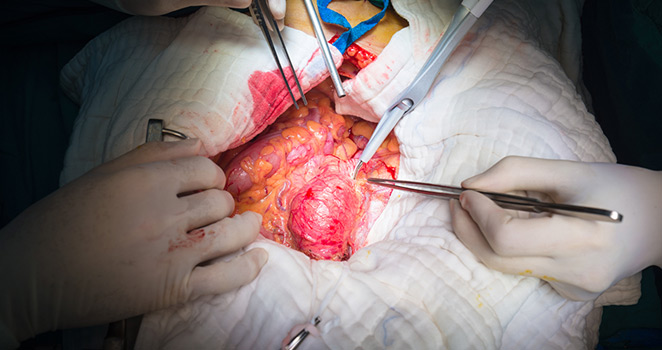Atrium Health Navicent Heart & Vascular Care
Open Abdominal Aortic Aneurysm Repair

An aneurysm is a dilated or bulging area that occurs along a weakened section of an artery. An abdominal aortic aneurysm, sometimes called an AAA, affects the lower part of the aorta, which runs from the heart through the center of the chest and abdomen. The aorta is approximately the size of a garden hose and provides the main blood supply for the body. A ruptured AAA can cause potentially life-threatening internal bleeding.
Abdominal Aortic Aneurysm Symptoms:
In many cases, abdominal aortic aneurysms develop and grow slowly with few symptoms. Once an AAA reaches a certain size, the patient may notice symptoms, including:
- A pulsating sensation near the navel
- Back pain
- Constant pain deep in the center or side of the abdomen
Smoking, hardening of the arteries, high blood pressure, trauma, infection or diseases that cause inflammation of the blood vessels, and heredity can all increase a person's risk of developing an abdominal aortic aneurysm. Caucasian males over the age of 65 are also at higher risk for an AAA. In addition to the possibility of rupture and internal bleeding, another complication of an AAA is the risk of blood clots that can break loose and travel elsewhere in the body.
Abdominal Aortic Aneurysm Surgical Indications:
Surgery to repair an aneurysm is generally recommended if an abdominal ultrasound shows that an aneurysm is at least 5 to 5.5 centimeters or if it is growing quickly. Surgery may also be recommended for smaller aneurysms if the patient is experiencing symptoms. Repairing the aneurysm significantly lowers the risk of rupture and has been shown to help individuals with large aneurysms to live longer.
Open Abdominal Aortic Aneurysm Repair Surgery:
An open surgery under general anesthesia is the traditional method of repairing an AAA. The goal of the surgery is to replace the defective section of the aorta with a fabricated prosthetic tube or graft. The procedure requires that a large incision be made in the center or side of the abdomen. The area above and below an aneurysm is clamped off to stop the flow of blood. In most cases, the defective section of the aorta is removed, and the graft put in its place. Depending on the type of aneurysm, the artery may be left intact with the graft placed inside the aneurysm. Once the graft is in place, the clamps are removed to allow blood to flow through the artery, and the incision is closed.
What to Expect After an Open AAA Repair Surgery:
Open abdominal aortic aneurysm surgery typically requires a three to a five-day hospital stay. Most patients experience incision site soreness and increased fatigue for the first few weeks following surgery. Patients are normally allowed to resume most activities within six weeks following surgery; however, it can take up to two to three months to regain full strength. Following an AAA repair, patients are advised to have follow-up tests, including ultrasounds or CT's, every few years to check for additional aneurysms and to monitor the status of the repaired aorta. Patients are also encouraged to stop smoking and to keep blood pressure and cholesterol under control to reduce their risk of developing future aneurysms.